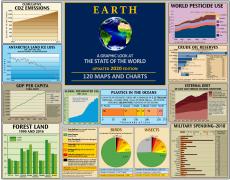Toxics & Biotechnology
A look at toxic chemical use (including Glyphosate, PCBs, DDT, dioxin, PBDE, lead, and mercury); safety testing; groundwater contamination; air pollution; the increase in biotechnology and pesticides in agriculture; nuclear toxicity.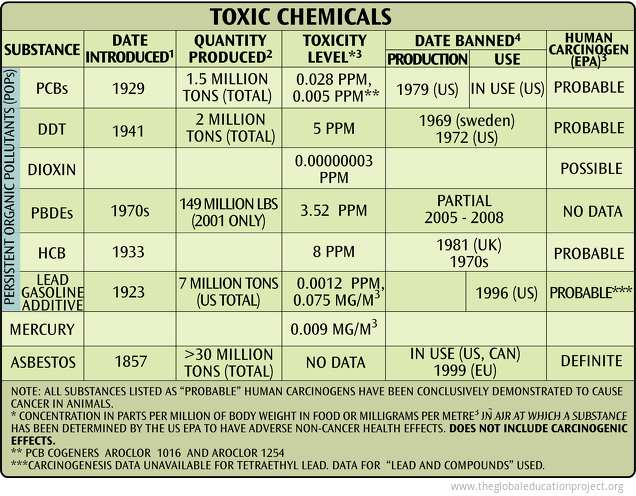 In 1998 the US Environmental Protection Agency did a study of the hazard data available on 2,863 chemicals that the US imported or produced in quantities greater than 1 million lbs/year. Most had never been tested to determine how toxic they were to humans or the environment. Only 7% of those chemicals had been subjected to the internationally accepted 6 basic tests. 43% had no available test data. Of the 203 chemicals on the toxic release inventory, only 54% had basic test data. Only 25% of 491 chemicals used by children and families in consumer products had full screening data. It would cost less than 0.2% of the total annual sales of the top 100 us chemical companies to fill all of the basic screening gaps for all these high production volume chemicals. - US EPA
In 1998 the US Environmental Protection Agency did a study of the hazard data available on 2,863 chemicals that the US imported or produced in quantities greater than 1 million lbs/year. Most had never been tested to determine how toxic they were to humans or the environment. Only 7% of those chemicals had been subjected to the internationally accepted 6 basic tests. 43% had no available test data. Of the 203 chemicals on the toxic release inventory, only 54% had basic test data. Only 25% of 491 chemicals used by children and families in consumer products had full screening data. It would cost less than 0.2% of the total annual sales of the top 100 us chemical companies to fill all of the basic screening gaps for all these high production volume chemicals. - US EPAOver 70,000 new chemicals have been brought into commercial production and released to the environment in the last 100 years.
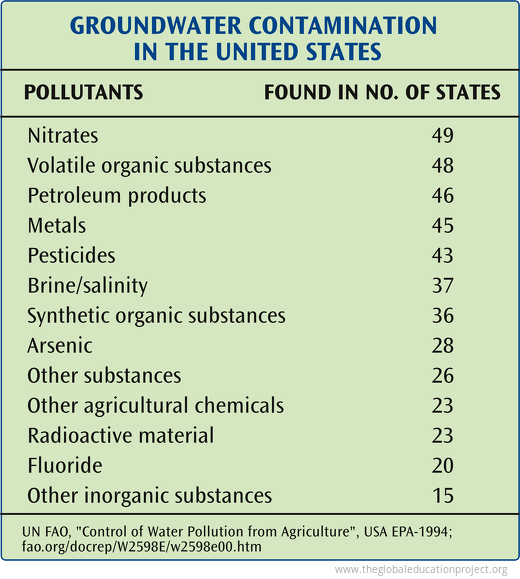 "60% of the most hazardous liquid waste in the United States, 34 billion liters of solvents, heavy metals, and radioactive materials, is injected straight into deep groundwater via thousands of injection wells..." [1]
"60% of the most hazardous liquid waste in the United States, 34 billion liters of solvents, heavy metals, and radioactive materials, is injected straight into deep groundwater via thousands of injection wells..." [1]"The industries requiring the most water are petroleum refining, food processing, metals, chemical processing, and pulp and paper... the industrial use of water... creates toxic and hazardous pollutants that renders waste water unfit for subsequent human consumption or use in the agricultural sector; these conditions can also permanently pollute aquifers. The expansion of industry to the developing world, in addition to local human contamination of fresh water supplies, is making it more difficult to maintain water quality." [2]
Groundwater Contamination
Groundwater contamination can occur from landfill, sewer and septic system leakage; agriculture use of pesticides, synthetic fertilizer and manure; hydraulic fracturing; commercial and industrial spillage and leaks; and sea level rise.The USGS posts a list of groundwater contaminants, both naturally and human caused, which includes: 26 inorganic contaminants; volatile organic substances; pesticides (herbicides, insecticides, fungicides, rodenticides); and microbiological contaminants and pathogens (bacteria, viruses and parasites).
The UN FAO reports that, globally, agriculture is the biggest polluter of water, creating serious water quality and health challenges throughout the world.
About 40% of the population in the US and 30% in Canada relies on groundwater for domestic use. About 43 million people in the US use private wells which are not regulated by the Federal Safe Drinking Water Act. In 2009, the U.S. Geological Survey (USGS) studied the water quality of over 2,000 private wells to measure the existence and extent of contamination and found that about 23% of them were contaminated at a level of potential health concern.
A rise in sea level forces underground water levels up, causing increased saltwater intrusion into fresh groundwater. Higher sea level (a consequence of climate change), particularly in low lying areas, can also contaminate groundwater by pushing to the surface toxic substances that have been underground for many years.
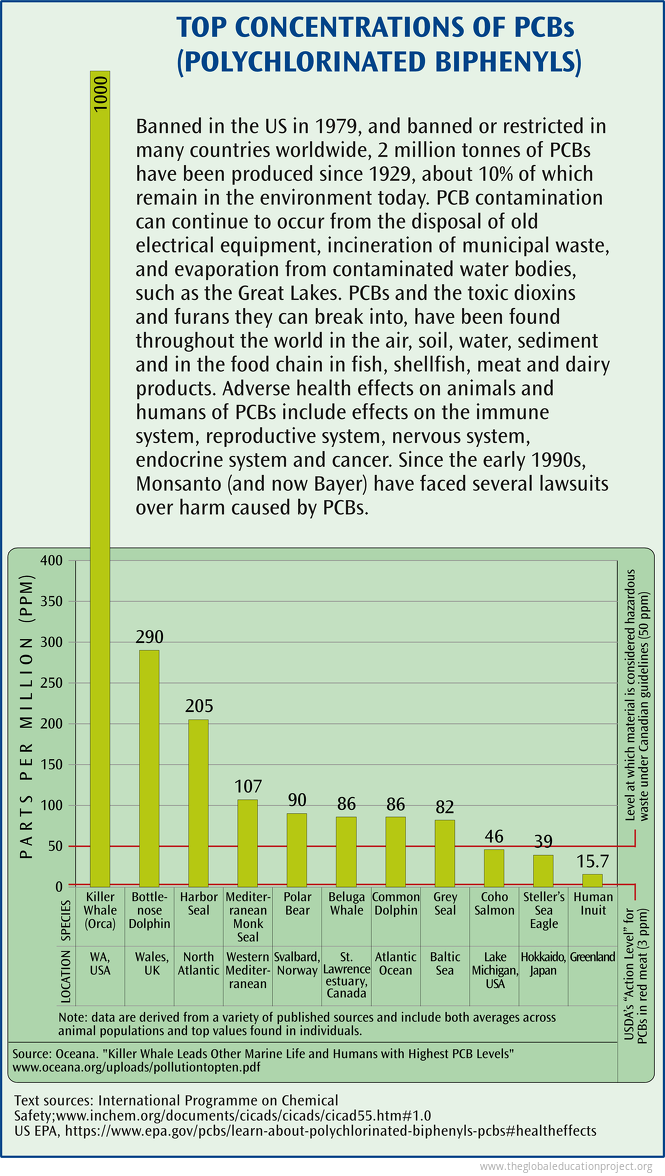
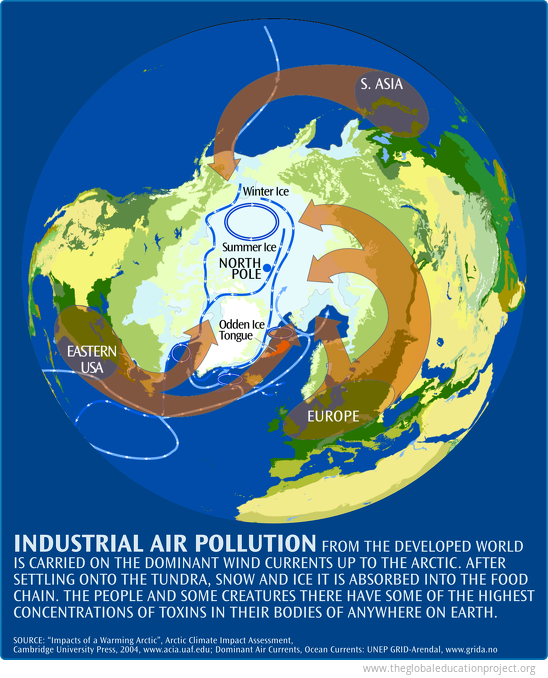 Industrial air pollution from the developed world is carried on the dominant wind currents up to the Arctic. After settling onto the tundra, snow and ice, it is absorbed into the food chain. The people and creatures there have had some of the highest concentrations of toxins in their bodies of anywhere on earth.
Industrial air pollution from the developed world is carried on the dominant wind currents up to the Arctic. After settling onto the tundra, snow and ice, it is absorbed into the food chain. The people and creatures there have had some of the highest concentrations of toxins in their bodies of anywhere on earth. 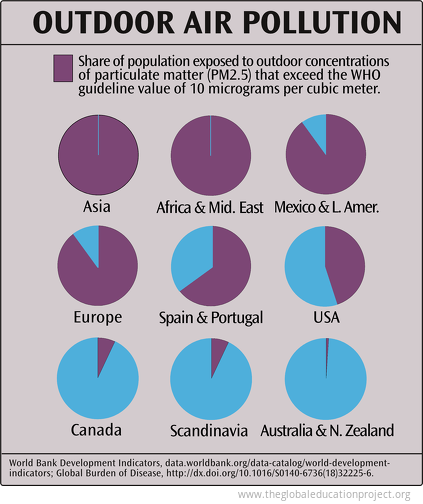 According to the 2017 Global Burden of Disease study, 3.4 million people died prematurely as a result of outdoor air pollution—more than 3 times the number who died from HIV/AIDS.
According to the 2017 Global Burden of Disease study, 3.4 million people died prematurely as a result of outdoor air pollution—more than 3 times the number who died from HIV/AIDS.Air pollution—the combination of outdoor and indoor particulate matter, and ozone—contributed to nearly 1-in-10 deaths globally in 2017.
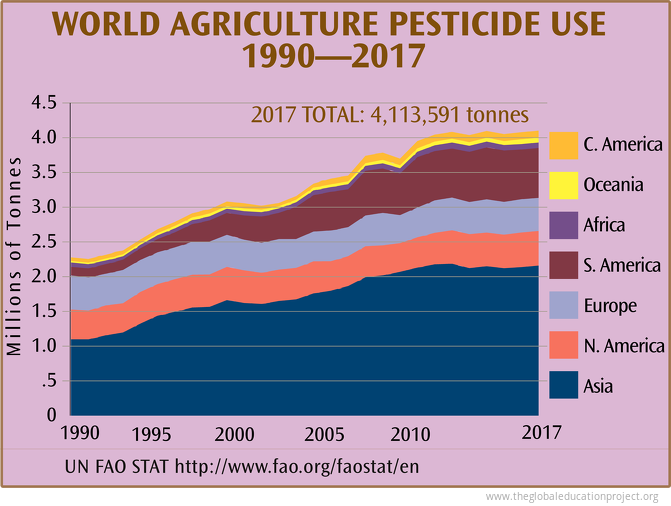
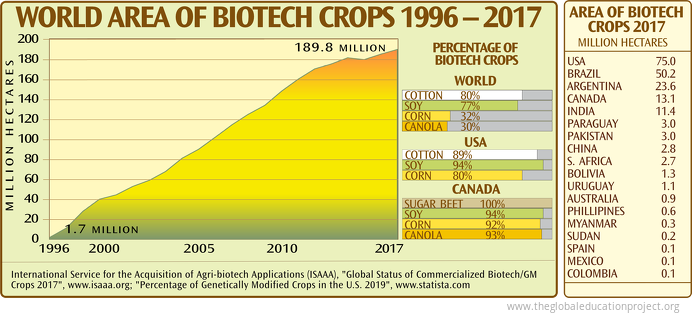 The development and release of genetically engineered organisms and their products has proceeded globally at a rapid rate, facilitated by vigorous partnerships between governments, scientists and corporations. 206 GMO crops are approved for use in the United States, and 183 in Canada. Millions of patents are in process and all living creatures are considered potential candidates for genetic modification and cultivation as bio-factories for human purposes and profit.
The development and release of genetically engineered organisms and their products has proceeded globally at a rapid rate, facilitated by vigorous partnerships between governments, scientists and corporations. 206 GMO crops are approved for use in the United States, and 183 in Canada. Millions of patents are in process and all living creatures are considered potential candidates for genetic modification and cultivation as bio-factories for human purposes and profit. By 2010, developing countries began to plant a larger portion of the world's biotech crops (53%) than industrialized countries (47%).
Glyphosate
"Roundup" is the trade name used by Monsanto (acquired by Germany's Bayer in 2018) for its glyphosate-based herbicide. Genetically modified Roundup Ready seeds are designed to grow crops that are resistant to glyphosate. Monsanto contracts prohibit the collection and saving of seeds by anyone using Monsanto's GMO seeds, requiring farmers to purchase seeds each year. Over time, weeds develop a tolerance to the herbicide, requiring increasing levels of application. Glyphosate is now the most widely applied herbicide in agriculture.Scientific studies show evidence that glyphosate leads to a wide range of health and environmental impacts including: worldwide contamination of drinking water sources, precipitation, and air, especially in agricultural regions; the half-life of glyphosate in water and soil is longer than previously recognized; glyphosate and its metabolites are widely present in the global soybean supply; human exposure is rising; and glyphosate is now authoritatively classified as a probable human carcinogen.
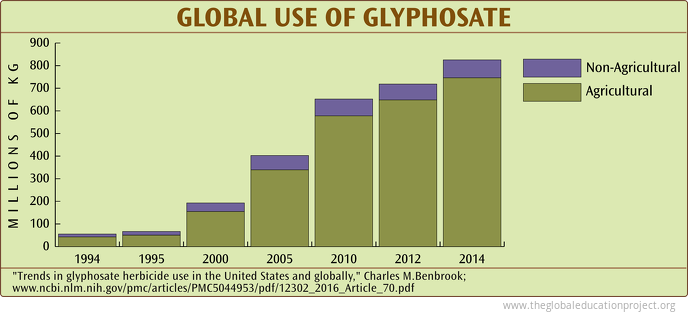
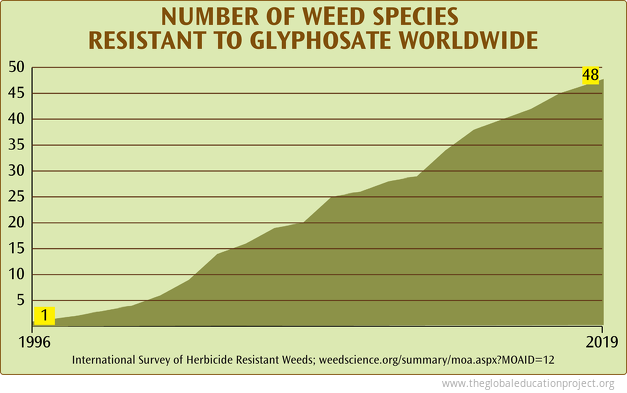
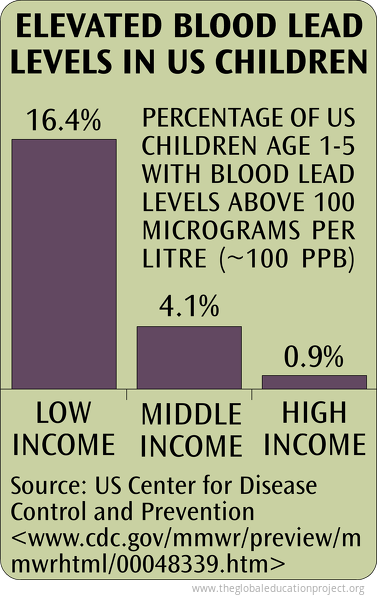 According to the CDC, more than half a million children ages 1 to 5 in the U.S. have blood lead levels high enough to damage their health, mostly from exposure to chips and dust of lead paint.
According to the CDC, more than half a million children ages 1 to 5 in the U.S. have blood lead levels high enough to damage their health, mostly from exposure to chips and dust of lead paint.Globally, it is estimated that in 2017, lead exposure accounted for 1.06 million deaths and 24.4 million years of healthy life lost worldwide due to long-term effects on health. The highest burden was in low- and middle-income countries. No safe blood lead level in children has been identified. Adverse health effects from lead include: behavior disorders, anemia, mental retardation, and permanent nerve damage. Effects of lead exposure cannot be corrected.
Sources
Toxic Chemicals Table:
Column 2. "Late lessons from early warnings: the precautionary principle 1896-2000." Europen Environment Agency Environmental issue report No 22 http://reports.eea.eu.int/environmental_issue_report_2001_22/en/tab_content_RLR
UNEP General Program of Action for the Protection of the Marine Environment from Land Based Activities — History of Persistent Organic Pollutants" http://pops.gpa.unep.org/04histo.htm;
US EPA http://www.epa.gov/history/topics/perspect/lead.htm;
London Hazards Centre http://www.lhc.org.uk/members/pubs/books/asbestos/asb13.htm
Column 3. "Late lessons from early warnings: the precautionary principle 1896-2000." Europen Environment Agency Environmental issue report No 22 http://reports.eea.eu.int/environmental_issue_report_2001_22/en/tab_content_RLR
US EPA "Persistent Organic Pollutants: A Global Issue, A Global Response" http://www.epa.gov/international/toxics/pop.htm
Environmental Working Group http://www.ewg.org/reports/taintedcatch/part1.php
EPA http://www.epa.gov/history/topics/lead/02.htm
LaDou, Joseph. "The Asbestos Cancer Epidemic" Environmental Health Perspectives Volume 112, Number 3, March 2004 http://ehp.niehs.nih.gov/members/2003/6704/6704.html
Column 4. US EPA Integrated Risk Information System (IRIS) http://www.epa.gov/iris/index.html
US Occupational Safety & Health Administration (OSHA) http://www.osha.gov/dts/chemicalsampling/toc/toc_chemsamp.html
Column 5. EPA web site http://www.epa.gov/history/topics/pcbs/01.htm;
UNEP General Program of Action for the Protection of the Marine Environment from Land Based Activities — History of Persistent Organic Pollutants" http://pops.gpa.unep.org/04histo.htm and New York Times February 23, 2002 http://query.nytimes.com/gst/abstract.html?res=F 70E13F93B5A0C708EDDAB0894DA404482&incamp=archive:search
UK Pesticide Safety Directorate http://www.pesticides.gov.uk/approvals.asp?id=55 and UNEP General Program of Action for the Protection of the Marine Environment from Land Based Activities — History of Persistent Organic Pollutants" http://pops.gpa.unep.org/04histo.htm
Column 6. US EPA Integrated Risk Information System (IRIS) http://www.epa.gov/iris/index.html
US Occupational Safety & Health Administration (OSHA) http://www.osha.gov/dts/chemicalsampling/toc/toc_chemsamp.html
Text:
US Environmental Protection Agency, http://www.epa.gov/oppt/chemtest/hazchem.htm
Groundwater Contamination in the US Table:
UN FAO Control of water polution from agiculture
1."Deep Trouble: The Hidden Threat of Groundwater Pollution", Payal Sampat, Worldwatch Paper 154, Dec. 2000, worldwatch.org
2. "The Strategic Importance of Water", Kent Hughes Butts, Parameters, http://carlisle-www.army.mil/usawc/Parameters/97spring/butts.htm
Groundwater Contamination Text:
USGS, "Contamination of Groundwater"; www.usgs.gov/special-topic/water-science-school/science/contamination-groundwater;
UN FAO, "More people, more food, worse water? A global review of water pollution from agriculture"; www.fao.org/3/ca0146en/CA0146EN.pdf
"Groundwater and the Rising Seas"; NEEF, neefusa.org/nature/water/groundwater-and-rising-seas
"What Threat Does Sea-Level Rise Pose to California?"; Legislative Analyst's Office of California, lao.ca.gov/reports/2020/4261/sea-level-rise-081020.pdf
Top Concentrations of PCBs in Animals Chart:
Oceana, "Killer Whale Leads Other Marine Life and Humans with Highest PCB levels" www.oceana.org
Text: International Programme on Chemical Safety;www.inchem.org/documents/cicads/cicads/cicad55.htm#1.0
US EPA, https://www.epa.gov/pcbs/learn-about-polychlorinated-biphenyls-pcbs#healtheffects
Arctic Geography, Winds, Ice, and Currents Map:
"Impacts of a Warming Arctic", Arctic Climate Impact Assessment, Cambridge University Press, 2004, www.acia.uaf.edu;
Dominant Air Currents, Ocean Currents: UNEP GRID-Arendal, www.grida.no
Outdoor Air Pollution Chart:
World Bank Development Indicators, data.worldbank.org/data-catalog/world-development-indicators; Global Burden of Disease, http://dx.doi.org/10.1016/S0140-6736(18)32225-6
World Agriculture Pesticide Use Chart:
UN FAO STAT; www.fao.org/faostat/en
Biotech Food Crops Chart:
International Service for the Acquisition of Agri-biotech Applications (ISAAA), "Global Status of Commercialized Biotech/GM Crops 2017", www.isaaa.org; "Percentage of Genetically Modified Crops in the U.S. 2019", www.statista.com
Glyphosate Text:
Trends in Gglyphosate Herbicide Use in the United States and Globally; UNEP Science Division brief: Alternatives for the Use of Glyphosate, environmentlive.unep.org/foresight; Concerns Over Use of Glyphosate-based Herbicides and Risks Associated with Exposures: A Consensus Statement, Myers et al. Environmental Health (2016); www.ncbi.nlm.nih.gov/pmc/articles/PMC4756530/
Global Use of Glyphosate Chart:
"Trends in glyphosate herbicide use in the United States and globally," Charles M.Benbrook; www.ncbi.nlm.nih.gov/pmc/articles/PMC5044953/pdf/12302_2016_Article_70.pdf
Glyphosate Resistant Weeds Chart:
International Survey of Herbicide Resistant Weeds; weedscience.org/summary/moa.aspx?MOAID=12
Elevated Blood Lead Levels In USA Children Chart:
US Center for Disease Control and Prevention, (CDC); https://www.cdc.gov/nceh/lead/prevention/blood-lead-levels.htm
World Health Organization, www.who.int/news-room/fact-sheets/detail/lead-poisoning-and-health
Tags: toxics & biotechnology
Sign up for EARTH Dispatches
Enter you email below to get jaw dropping charts and maps delivered straight to your inbox.
Get the EARTH presentation
A 150 page high-resolution PDF containing all updated maps, charts and data on EARTH website; use as an information-packed educational slide show, printed booklet or a set of single-page handouts.
Learn More
